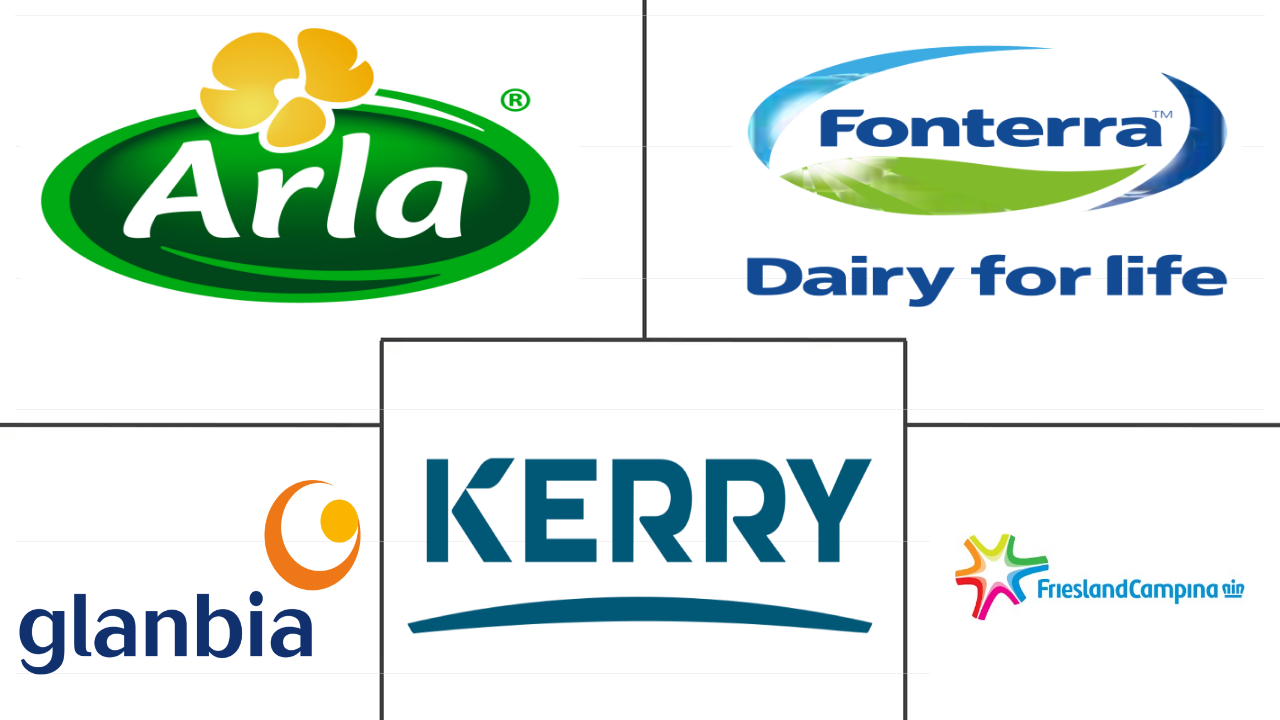Market Size of asia-pacific milk protein Industry
| Icons | Lable | Value |
|---|---|---|
|
|
Study Period | 2017 - 2029 |
|
|
Market Size (2024) | USD 391.51 Million |
|
|
Market Size (2029) | USD 503.59 Million |
|
|
Largest Share by End User | Food and Beverages |
|
|
CAGR (2024 - 2029) | 5.16 % |
|
|
Largest Share by Country | China |
Major Players |
||

|
||
|
*Disclaimer: Major Players sorted in no particular order |
Asia-Pacific Milk Protein Market Analysis
The Asia-Pacific Milk Protein Market size is estimated at 391.51 million USD in 2024, and is expected to reach 503.59 million USD by 2029, growing at a CAGR of 5.16% during the forecast period (2024-2029).
391.51 Million
Market Size in 2024 (USD)
503.59 Million
Market Size in 2029 (USD)
4.69 %
CAGR (2017-2023)
5.16 %
CAGR (2024-2029)
Largest Market by Form
52.66 %
value share, Isolates, 2023
The superior qualities and functionalities of MPIs, like high protein content, lower carbs, and lower lactose content, make them the leading form of milk protein.
Largest Market by End User
80.64 %
value share, Food and Beverages, 2023
The F&B segment leads the market, majorly driven by the snacks, bakery, and beverage sub-segments. The rise in functional F&B is boosting the demand for protein ingredients.
Fastest Growing Market by Form
5.26 %
Projected CAGR, Concentrates, 2024-2029
Increased demand in the personal care sector and growing research confirming the benefits of hydrolases, such as reducing skin allergies, are projected to drive the segment.
Fastest Growing Market by End User
5.92 %
Projected CAGR, Personal Care and Cosmetics, 2024-2029
In terms of convenience and product formulations, milk protein innovation is gaining traction, mainly in the nutricosmetics category, due to its hydration property.
Leading Market Player
24.41 %
market share, Fonterra Co-operative Group Limited, 2021

Fonterra Co-operative Group Limited gained a competitive edge over other players due to its extensive product portfolio. It also engages in strategic moves toward innovation.
Food and beverages leads the market with 84% market share, supported by the varied usage of milk protein in snacks, beverages, and bakery industries
- The higher functionality of milk proteins drives their application in the F&B segment in combination with other protein sources. To cater to more health-conscious consumers, manufacturers have produced a variety of beverages, reduced-fat snacks, and more in bakeries as egg replacements. Nutritionally fortified foods offer a significant opportunity for the business in the milk protein segment. The trend in protein across food and beverages makes protein fortification a top choice, and consumers are looking for protein and fiber claims while purchasing. The milk protein market is majorly dominated by the F&B sector in 2023, where 84% by value of its application is shared by the snacks, beverages, and bakery industries.
- Milk proteins account for a large portion of the supplements market, primarily rising in baby formula at a CAGR of 5.08% by value over the forecast period. Packaged baby foods are common in cities because they provide appropriate nutrients for infants. In 2021, the female labor force participation rate in India was 19.23%. An increase in the number of working mothers has encouraged infant food firms to create nutrient-rich products like milk protein supplements to meet the region's growing demand for easy nourishment.
- Milk protein's high efficacy in egg replacement is boosting its demand in the bakery industry. It had an application share of 53% by volume in 2022. For countries like China, where Avian flu is a budding concern, milk protein is expected to surge further amid egg replacement trends. Milk protein ingredients help formulators meet growing consumer demand for more nutritious and delicious bakery offerings across a wide range of applications such as bread, cakes, pastries, cookies, and crackers, as well as icings, fillings, and glazes.
With country's experiencing a shift in population's acceptance of healthy and protein-fortified drinks. India ranked 3rd behind China and Rest of Asia-Pacific countries
- In 2022, China maintained its top position. Milk protein's increased appeal in specialist product categories such as newborn nutrition, clinical diets, sports, and weight training was ascribed to this. High-protein goods have recently received significant public attention in China, identifying protein as one of the most desired elements before food purchase. In 2020, over 36% of Chinese citizens were interested in purchasing high-protein food products. The country is expected to have the biggest development potential throughout the forecast period, with a CAGR of 5.01% in terms of value.
- Next to China, India has been witnessing a constant rise in health-conscious consumers. The steady rise in obesity rates among Indians has shifted the population's acceptance of healthy and protein-fortified drinks. In 2021, the percentage of overweight women rose from 20.6% to 24%, while in men, the number increased from 18.9% to 22.9%. Milk proteins help reduce overall calorie intake and decrease the desire for sweet and high-calorie foods. When combined with a regular exercise routine, MPI or MPC can help people lose weight healthily and sustainably. Hence, the country is projected to have the second-fastest growth in the forecast period, with a CAGR of 4.62% by value.
- The supplement segment of the milk protein market is projected to register a CAGR of 2.90% by value in the forecasted period in Australia. The substantial growth of key application sectors like medicinal and sports nutrition supplements is anticipated to drive the milk protein market for dietary supplements in the coming years. In 2021, nearly half of Australians of all ages (46.6%) had one or more chronic conditions, and almost one in five (18.6%) had two or more chronic conditions.
